- Home
- Past News & events
- 2008
Seminar: Metal Oxide Quantum Rods & Dots Structures & Devices: Design, & Electronic Structure
 31st October 2008 – 12:00
31st October 2008 – 12:00
Speaker:
Dr. Lionel Vayssieres
Location:
Aula Seminari Dip. Sc. e Tec. Chimiche, Campus
Abstract:
The demand of novel functional materials has become the major challenge scientists face to answer crucial contemporary issues such as alternative energy sources, novel sensors for a safer and cleaner environment and for health (e.g. early detection of cancer and regenerative therapies). For instance, one of the promising alternatives for the transition of energy resource from its fossil fuel-based beginning to a clean and renewable technology relies on the widespread implementation of solar-related energy systems, however the high cost of energy production and low-energy of currently used material combinations pose an intrinsic limitation. In this context, revolutionary materials development is required to achieve the necessary dramatic increases in power generation and conversion efficiency. The need of low cost purpose-built, functional materials with optimized geometry, orientation, and aspect ratio combined with inexpensive large scale manufacturing methods will play a decisive role in the success of solar related energy source. However, fabricating and manufacturing large area of such functional materials is a daunting challenge. Novel smarter and cheaper fabrication techniques and, just as important, better fundamental knowledge and comprehensive understanding of materials and their syntheses as well as their properties using nanoscale phenomena such as quantum confinements to create multi-functional structures and devices is the key to success. R&D exploiting Nanoscience and Nanotechnology has the greatest potential to reach such challenging goals.
Such ideas will be demonstrated by the low-cost design and fabrication of 3-D crystalline arrays of metal oxide quantum dots and rods based structures and devices with controlled orientations, size and shape onto various substrates designed at nano-, meso-, and micro-scale by aqueous low-temperature chemical growth. In addition, in-depth characterization of their electronic structure at synchrotron radiation facilities and their application for solar hydrogen generation, photovoltaics, magnetic and gas sensor devices will be presented.
Seminar: Organic Semiconductor-Based Devices and Nanostructures
 30th October 2008 – 15:00
30th October 2008 – 15:00
Speaker:
Prof. Franco Cacialli
Location:
U.M. Grassano, Campus
Abstract:
Conjugated molecular and supramolecular materials now provide a class of semiconductors in its own right, with potential application to devices such as light-emitting diodes, LEDs, displays, transistors, and solar cells, now mature for both large-scale industrial take-up and commercial exploitation. After a brief introduction to conjugated polymers, I will present an electro-optical technique for the non-invasive probing of internal built-in fields in sandwich devices (LEDs or solar cells) and, in combination with data from ultraviolet photoelectron spectroscopy (UPS) and Kelvin Probe characterisation, for the analysis of the energy level line-up at organic semiconductors/electrodes interfaces. I will also present an approach to high-resolution lateral patterning of an electroluminescent conjugated polymer, based on near-field lithography with apertured probes. The technique is based on the spatially selective inhibition of the solubility of the polymer precursor by exposure to the UV field present at the apex of double-tapered, gold-coated probes [aperture diameters between 40 and 80 nm (±5 nm)]. After development in methanol and thermal conversion under vacuum we obtain features with a minimum dimension of 50 nm. I will also report results on heating of the SNOM apertured probes resulting from the combined effect of significant absorption in the metallic coating and small optical throughput of the probes. Implications for microspectroscopy and lithography will also be discussed. Insulated molecular wires made with conjugated-polymers-based polyrotaxanes offer an example of an alternative, bottom-up approach to electroluminescent nanostructures. An attractive feature here is that this class of materials is engineered at a supramolecular level by threading a conjugated macromolecule, such as poly(para-phenylene), poly(4,4-diphenylene vinylene) or poly(9,9-fluorene) through a- or b-cyclodextrin rings, so as to reduce intermolecular interactions and solid-state packing effects, that red-shift and partially quench the luminescence. Such a supramolecular approach preserves the fundamental semiconducting properties of the conjugated wires, and is effective at both increasing the photoluminescence efficiency and blue-shifting the emission of the conjugated cores, in the solid state, while still charge-transport. We used the polymers to prepare a range of LEDs and light-emitting electrochemical cells (LECs). The reduced tendency for polymer chains to aggregate shows in both solid-state films, as well as in solution (as clearly demonstrated by time-resolved fluorescence studies) and allows solution-processing of individual polyrotaxane wires onto substrates, as revealed by scanning-force microscopy.
Seminar: Applications of Fluorescence Spectroscopy, Circular Dichroism and SAXS in the conformational studies of lectins
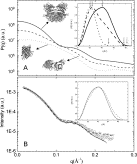 18th July 2008 – 11:00
18th July 2008 – 11:00
Speaker:
Prof. Patricia Targon Campana
Location:
U.M. Grassano, Campus
Abstract:
The understanding of the relation between the protein structure and its function is an important challenge in Science, since proteins are involved in all crucial process for life appearing and maintenance. In this sense, the comprehension of stability and conformational mechanisms that can interfere in the protein function is essential to achieve the knowledge and subsequent treatment of several pathologies. Among the most interesting proteins for these studies one can find the lectins: proteins that present the ability to bind carbohydrates specifically and in a reversible way. As carbohydrates can be found in cell membranes, this special feature makes these proteins proper to mediate molecular recognition processes as cell proliferation, cell-cell and cell-virus interactions. Although those proteins have been extensively studied during the last decades, new lectins with interesting properties have been isolated and even the most studied ones presented open questions about their biological function and conformational changes as well. In this sense, this talk aims to present some conformational studies of lectins and other proteins with biotechnological application that have been performed in several structure levels. The changes in secondary structure by means of Far-UV Circular Dichroism, steady-state and phase domain fluorescence at aromatic vicinities and tertiary and quaternary levels using Small-Angle X-Ray Scattering (SAXS) will be presented.
Conference Paper: Photonic devices based on patterning by two photon induced polymerization technique
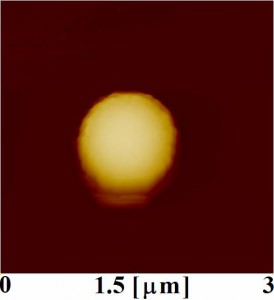 Strasbourg, France
Strasbourg, FranceDOI: 10.1117/12.786414 Conference: Conference on Nanophotonics II, Volume: 6988
Conference: NanoSEA 2008
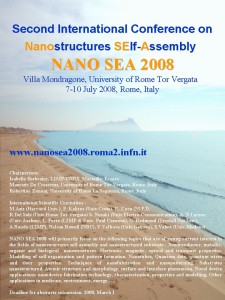
Rome, 7th – 10th July, 2008
Second International Conference on Nanostructures SElf-Assembly
Location:
Villa Mondragone, Università degli Studi di Roma Tor Vergata
Monteporzio Catone, Rome, Italy
NANO SEA 2008 will primarily focus on the topics that are of strong current interest in the fields of nanostructures self-assembling and nanostructured substrate
Related Information:
Web site
Contacts:
Prof. Maurizio De Crescenzi
Conference: Connect Research 2008
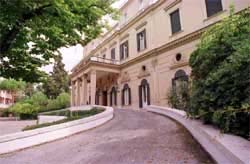
Rome, 8-9 May, 2008
Connect Research 2008, Strategies and Approaches to Compete in a Global Market
Location:
Villa Wolkonsky, Via Ludovico di Savoia – Rome
Related Information:
Programme
Invite
ISIS – New neutron facility for fast neutron irradiation tests of electronics
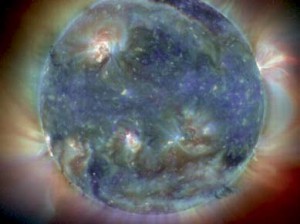 Single Event Effect (SEE)
Single Event Effect (SEE)
Collaborative research among Italian and British scientists and engineers from Universita’ di Roma Tor Vergata (Nast Centre), CNR (I), ISIS Spallation neutron Source (UK), Universities of Central Lancashire, Padova and Milano Bicocca, and from the avionics and aerospace industries have been using VESUVIO neutron flux and energy spectrum in benchmark activation measurements to demonstrate that it provides a neutron spectrum similar to the ambient one at sea level, but with an enhancement in intensity of a factor hundred .The VESUVIO beam line at the ISIS spallation neutron source UK Facility over the last few months has been set up for neutron irradiation tests in the neutron energy in the MeV range. The neutron production at ISIS relies upon spallation reactions induced by 800 MeV proton bunches, accelerated through a synchrotron. Carla Andreani, Professor of condensed matter at the University of Rome, Tor Vergata, begins the story, “I was collaborating with ISIS on a project developing the VESUVIO spectroscopy instrument when a colleague put me in touch with ST Microelectronics which was look- ing to access the Los Alamos neutron source in the USA. I proposed doing a feasibility study at ISIS instead.” A team the three Italian universities and a team of ISIS, along with ST Microelectronics car- ried out chip irradiation testing on field-programmable gate arrays (FPGA’s) which form the basis of many microelectronic devices.
New: NAST Centre & Toyota
 Toyota funding for a laboratory of advanced research on fuel cells in Rome and the result of the agreement signed in the Japanese capital in recent days between The University of Tokyo and that of Tor Vergata for the creation of a joint laboratory for the car hydrogen
Toyota funding for a laboratory of advanced research on fuel cells in Rome and the result of the agreement signed in the Japanese capital in recent days between The University of Tokyo and that of Tor Vergata for the creation of a joint laboratory for the car hydrogen


